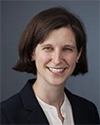Researcher shows how racially based tools to separate science students persist
LAWRENCE — The recent U.S. Next Generation Science Standards seek to address long-standing problems of some populations of students being underserved and not receiving the same quality education as their peers. The standards refute deficit-oriented views about the capabilities of students from historically underserved groups. However, the standards also divide students in ways that threaten to exacerbate unequal education, according to a University of Kansas researcher.
 Kathryn Kirchgasler, lecturer in curriculum & teaching, has been studying how U.S. students have been separated into different levels of science classes for more than a century and how research and standardized testing have perpetuated those inequalities. She recently published a book chapter and is preparing a journal article and upcoming book on the topic. The chapter, “Scientific Americans: Historicizing the Making of Difference in Early 20th-Century U.S. Science Education,” traces the history of testing to determine which students were deemed “capable” of learning high-level science and argues that these tools inserted judgments and values about the “right” kind of child that persist to this day.
Kathryn Kirchgasler, lecturer in curriculum & teaching, has been studying how U.S. students have been separated into different levels of science classes for more than a century and how research and standardized testing have perpetuated those inequalities. She recently published a book chapter and is preparing a journal article and upcoming book on the topic. The chapter, “Scientific Americans: Historicizing the Making of Difference in Early 20th-Century U.S. Science Education,” traces the history of testing to determine which students were deemed “capable” of learning high-level science and argues that these tools inserted judgments and values about the “right” kind of child that persist to this day.
What’s worse, these judgments operate invisibly as they are embedded in a notion of “science” that does not reflect what scientists do. As teachers and school administrators separate students, they may rely on tools and theories built on historical assumptions of difference that work against their efforts to combat racial disparities.
“How students are divided in current policy shares some of the same assumptions made 100 years ago, when immigrants from southern and eastern Europe were seen as not ready for or interested in physics and chemistry,” Kirchgasler said. “Trying to close so-called achievement gaps can paradoxically create new inequities by the tools we use to assess them. The premise that demographic groups have different learning needs can actually set students onto distinct trajectories that culminate in the de facto racial segregation of high school courses.”
Kirchgasler’s chapter appears in the book “A Political Sociology of Educational Knowledge: Studies of Exclusions and Difference,” co-edited by Thomas Popkewitz, Jennifer Diaz and Christopher Kirchgasler, assistant professor of curriculum studies at KU. In the chapter, the author examines the history of methods to determine which students were “fit” for certain science classes. Kathryn Kirchgasler analyzed a major science education journal, General Science Quarterly, published from 1916 to 1929, and found that the general science course spreading across the U.S. at the time was designed in part to “Americanize” children from populations regarded as “unscientific.”
Kathryn Kirchgasler traces how educational leaders of the time visualized “scientific thinking” as an American virtue by contrasting it with an imagined “primitive mind” and with “foreign superstitions” attributed to immigrant groups. It was commonly believed students began as concrete thinkers, not abstract, and that certain groups could not handle subjects like physics until much later in their schooling, if at all. She goes on to explore the rise of standardized testing and the home survey. The latter arose in response to early 1900s movements promoting physical and mental hygiene. The survey instructed teachers to ask students about their daily hygiene habits. Cultural norms, such as bathing frequency, were conflated with the parents’ “ignorance of science” and the child’s “need” for concrete health instruction over abstract scientific knowledge.
In ongoing research, Kathryn Kirchgasler is illustrating findings to show how similar measures have remained a way of determining students’ “needs” in relation to science learning and how this history relates to recent data-driven reforms.
“Dividing students by assumed capability and needs links back to a racialized history in U.S. schooling,” Kirchgasler said. “Cultural assumptions get built into the psychological tools, data and algorithms we use to sort students today.”
Ironically, using data to drive course placement can result in students from underserved groups being separated into classes that don’t teach the same content, leading to unequal access to those courses that serve as gatekeepers to college and STEM-related careers.
Kirchgasler argues that in order to address the inequitable separation of students, researchers, educators and policy makers alike must realize that dividing students by perceived need can inadvertently exacerbate racial disparities in education. Addressing the issue in teacher education would also be important, Kirchgasler said, as teachers rarely have the chance to analyze the histories of those theories and tools they are expected to use to classify students.
The chapter concludes by pointing out that, while the Next Generation Science Standards have moved far beyond the home surveys and methods of the past, they still consider science a “universal quality of mind” that can be calculated on standardized measures.
“These data fabricate a division between certain racial and ethnic groups as requiring interventions to meet the standards and their unmarked peers as deserving opportunities to exceed this baseline,” Kirchgasler wrote. “Rather than critiquing tracking as an equity problem, the stratification of science courses is naturalized as a reasonable response to the distinct achievement levels ascribed to racialized groups.”
This way of thinking of science as a property of some minds and not others has less to do with what scientists do and more with historical assumptions of different categories of people.